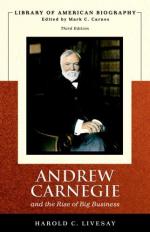
|
| Name: _________________________ | Period: ___________________ |
This test consists of 15 multiple choice questions and 5 short answer questions.
Multiple Choice Questions
1. Beginning in 1872, Carnegie focuses on the single project of his steel-rail rolling mill that is completed in _________.
(a) 1903.
(b) 1893.
(c) 1873.
(d) 1883.
2. As mills become more efficient, the need for raw material continues with deposits from _______________________.
(a) Michigan, Wisconsin and Minnesota.
(b) New York, Pennsylvania, and Maryland.
(c) Indiana, Kentucky, and Illinois.
(d) Alabama, Alaska, and Arizona.
3. American capitalism and democracy conflict in the fear that economic justice requires what?
(a) An active interventionist role for government.
(b) An inactive government.
(c) Small government.
(d) No government.
4. Tom Miller is a _________ man who forms joint ventures with Carnegie in several small investments. They form Freedom Iron Company of Lewiston Pennsylvania in 1861 that Carnegie restructures into Freedom Iron and Steel to retool for the Bessemer process in 1866.
(a) Automobile.
(b) Technology.
(c) Railroad.
(d) Industrial.
5. Carnegie pressures management and Frick resigns again. Is his resignation accepted?
(a) Not at first.
(b) Yes.
(c) No.
(d) Only later.
6. Carnegie leases the iron ore properties from this man. Why?
(a) To keep him happy.
(b) To retire slowly from the industry.
(c) To make him a partner.
(d) To keep him out of the steel business.
7. Carnegie sells _____________ bonds to Junius Morgan in London to complete construction of the Edgar Thomson Works in 1875, and saves 25 percent in costs from the depression.
(a) $4 million.
(b) $40,000.
(c) $4,000.
(d) $400,000.
8. The 1878 Thomas process of lime-lining the heating vessel to eliminate phosphorous is acquired by Carnegie and sold to who two years later?
(a) The Bessemer Association.
(b) The Mellon Association.
(c) The Roosevelt Association.
(d) The John D. Rockefeller Association.
9. What firms are formed and the Gilded Age develops in New York?
(a) Restaurants and fast food chains.
(b) Bank and credit unions.
(c) Retail and mercantile.
(d) Technology and communication.
10. In __________, Carnegie has the most modern operation.
(a) 1880.
(b) 1878.
(c) 1879.
(d) 1875.
11. Phipps buys flue-cinder at fifty cents a ton and sells puddle-cinder at ________ per ton to improve Lucy furnace product and save money.
(a) $1.50.
(b) $0.50.
(c) $2.50.
(d) $3.50.
12. Frick's chairmanship of the Carnegie Company marks a difficult period in its history starting with what strike in 1892 and a four year depression from 1893.
(a) UPS Workers Strike.
(b) The Homestead Strike.
(c) Postal Worker's Strike.
(d) The Pullman Strike.
13. One of the country's largest banking houses Jay Cooke's collapses, credit structures tumble and _____________ businesses fail in a year.
(a) 50,000.
(b) 500.
(c) 1,000.
(d) 5,000.
14. At thirty, Frick is a millionaire with _______ thousand coke ovens and three thousand acres of land.
(a) Two.
(b) Four.
(c) Three.
(d) One.
15. Only how many of the original nine partners remain?
(a) Four.
(b) Two.
(c) Three.
(d) Five.
Short Answer Questions
1. What problems does this steel company have?
2. Schwab cuts $500,000 in costs at Homestead by __________________ and replacing skilled labor with machines and unskilled workers.
3. Captain Bill Jones claims success in managing labor by doing what?
4. Andrew needs a strong leader to manage growth after what happens to his brother Tom?
5. Carnegie hires Captain Bill Jones to raid whose staff where they worked together before its strike to run ET?
|
This section contains 509 words (approx. 2 pages at 300 words per page) |

|




